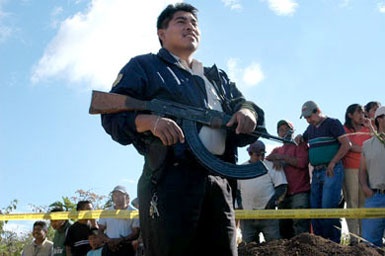Guatemala: Heartbreak and Hope
The stories of Guatemalans reveal a community haunted by civil war and genocide and threatened by the drug trade and gang violence.

Two butterflies danced in the warm ari at the cave's entrance. Their pale yellow wings were shot
through with fine black bands.
Soft as whispers, delicate as dreams, they hovered untouched by the horror nearby.
The six dead lay just inside. All executed, shot in the head, then left to rot. Most were men in their late teens or just out of them. The youngest boy was 14. One was a girl, 18, her belly swollen with her unborn baby.
Hours earlier, more than a dozen uniformed men, with assault rifles and pistols, showed up outside the victims’Guatemala City homes. The captives were forced into vehicles with tinted windows.
Their bodies were discovered just after sunrise by somebody looking for a missing dog.
The cave, inside a sand pit on the outskirts of the city, was a popular dumping ground with the death squads that prowled the country during the 36-year civil war.
The 1996 peace accords were supposed to end this business of kidnappings and killings in the dark. It hasn’t worked out that way.
The murder rate in Guatemala is six times that of the United States, when adjusted for population.
More than 4,300 Guatemalans were killed in 2004. The murders found in the cave Jan. 14 were part of the bloody christening of 2005.
Cocaine, and the business of cocaine, are behind much of the killing. A $30 gram of coke sold in Washington state likely cost a Guatemalan his life.
The connection to the killing, 3,000 miles away, really is as close as the nearest crack pipe or coffee table with stray crumbs of white powder.
Guatemala is the main staging area for cocaine traffickers smuggling drugs from South America into the U.S.
The federal Drug Enforcement Administration estimates up to 70 percent of the cocaine entering the U.S. first moves through Guatemala. It arrives on airplanes flying one-way journeys into the jungles. It’s ferried along the coast by “go-fast” boats. It’s hidden in shipping containers.
Once on the ground, the drugs are routed to cities throughout the U.S. — to Los Angeles, Seattle, Everett.
Arrests for drug trafficking in Guatemala are rare. Arrests aren’t made in 95 percent of murders. Convictionsare rarer still.
Entrenched corruption in the Guatemalan government and a lack of workable laws have blunted that nation’s ability to respond.
The result is more violence, something Guatemalans have known for decades.


































































































